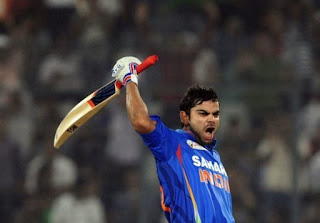This first appeared on Sportskeeda.
Kohli and Amla? Too many runs and too much consistency in
one sentence already.
When it comes to batting in ODI internationals, very few
names crop up when it comes to matching the level of consistency that Amla and
Kohli have displayed throughout their careers.
Scoring runs, prolifically at that, has become such a differentia
with these batsmen that a 30-odd score is subliminally thought of as an off day
for them. And if a few innings pass by without being adorned by a sizable
enough score, the anticipation building around those two is palpable. And
invariably, they deliver, with eerie regularity. These similarities apart, who
makes for a better ODI run machine?
First, let’s go with Kohli.
He prominently features among the top tier batsmen when
classified according to the number of runs scored in ODIs in the current
calendar year. No surprises there, it’s business as usual for him. He has been
doing that for the past three years, and even topped the charts in 2011.
Comparisons with Sachin do the rounds, which per se is
unfair to any batsman. But, spectacularly, he hasn’t disappointed. Following in
his footsteps, he, too, has developed a penchant for renaming records.
 |
| Kohli : rewriting record books |
Records have been tumbling in his wake for some time now. He
is the second fastest batsman after Sir Viv, and fastest Indian, to complete
4000 runs in ODIs, and has a chance at eternal glory to become the fastest to
5000 ODI runs. He already has 15 ODI centuries, that too from the least number
of matches in the history of cricket, and beats the nearest competitor
comprehensively. He is also the youngest to have ever done that.
His conversion rate of about 0.63 is also the best in
history.
His performances in crunch situations, especially while
chasing, bear testament to his rise as India’s best and most reliable batsman. He
is the first batsman in the history of ODI cricket to average more than 60 per
dismissal while chasing. 133 at Hobart, which witnessed the decimation of Malinga,
or the 183 against Pakistan in the 2012 Asia Cup speak volumes about his import
as an important cog in the wheel of Indian batting.
Another for the books: he is the fourth most successful
batsman in the history of ODI cricket as regards successful chases.
A natural at the shorter formats of the game, he took his
time but has eventually managed to showcase his adaptability to the longer
version of the game. He hasn’t been as spectacular, but has managed an
impressive conversion rate in the longer format as well.
Amla, however, pales in comparison when it comes to
possessing landmark records. This, however, is only one small part of a much
larger picture.
His batting possesses virtually none of the atrocious shot
making many of the other modern day batsmen employ, hence none of the
mini-orgasmic oohs that define Gayle or his compatriot de Villiers. He probably
belongs to the old school of batting wherein anything unconventional was a
sacrilege. He goes about his job nonchalantly and without much fuss.
Hence his prominence in Test matches, but what about ODIs?
His domination in the 50-over format is news for many. Amla
had to make his mark in test match cricket before being considered for ODIs,
much the opposite when compared to Kohli. Logically, the transition should have
been difficult, or at least should have taken time before he made it big.
 |
| Amla : Not far behind Kohli |
For a batsman who had been touted as a test specialist, an average of around 55, much better than Kohli’s, underlines his indispensability
in the one-day format.
Plus there is also his strike rate of 91 runs per 100 balls
faced, exceptional for someone looked upon as fitting something like the
Dravid-mold. It is almost romantic how cricket throws up these incongruities
that makes people fall in love with the game all over again.
There has been much hue and cry about Kohli getting to 4000
runs second fastest, but few might have noticed Amla creeping up the
runs-ladder, now set to overtake Kohli at least in this regard.
It might come as a revelation to many, but Amla has 11 ODI
tons in 73 innings, which is remarkable and looks a notch better than Kohli’s
15 in 108 innings. Agreed, two tons against Zimbabwe and one against the Dutch
take some of the sheen away from his batting. But you can’t just point out
foibles like these. What should have he done? Refuse to play with minnows?
Add to that 21 half-centuries- that makes his conversion
rate 0.53 odd in ODIs, though less than Kohli’s, but still exemplary.
Amla’s preeminence in the test arena might beckon people to
proclaim him as a better batsman, considering how ODI stats remain
inconclusive. But, again, the relatively meager number of matches that Kohli
has featured in fails to give weight to this argument.
Asking to choose between these two ODI greats of the modern
game is like asking to choose between Warne and Muralitharan as to who was a
better test bowler, where records and stats can only tell you so much.
All in all, record books do revere Kohli for now. But the
threat of another invader looking to upset the books looms large.
No comments:
Post a Comment